A Magazine for the Production Industry




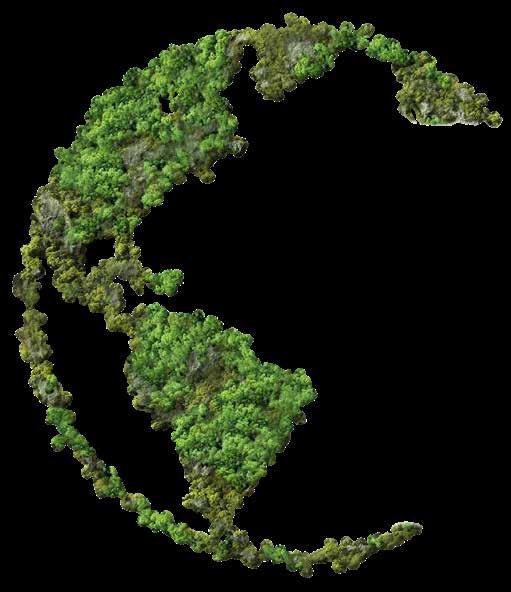
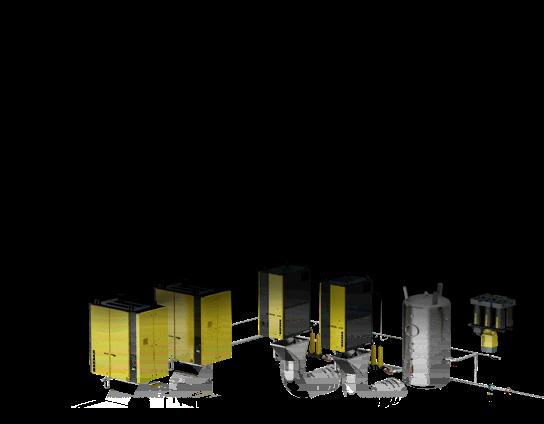
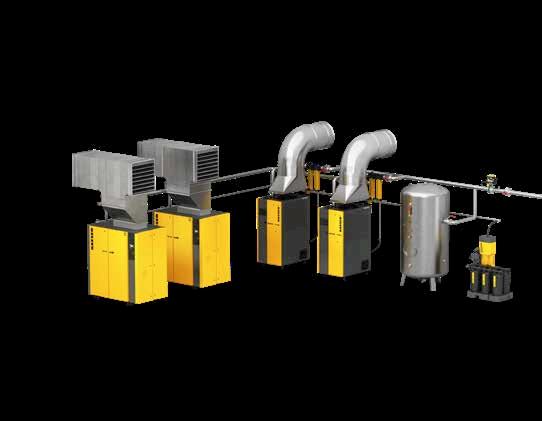
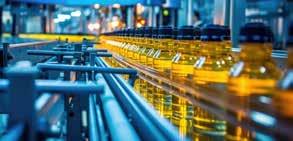
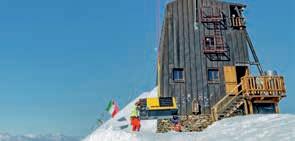


A passion for radiant smiles Pioneers in industrial manufacturing for dental technology
The highest construction site in Europe Portable compressors in the service of science
Integrated and intelligent energy use The aerosol cans of the future
and innovation with international excellence On the road to success with heat recovery
A magical world
Viennese Snow Globe Manufacture” since 1900
Craft beer from Down Under Sustainability with state-of-the-art technology
Published by: KAESER KOMPRESSOREN SE, 96450 Coburg, Germany, Carl-Kaeser-Str. 26 Tel. +49 (0)9561 640-0, Fax +49 (0)9561 640-130, www.kaeser.com, E-mail: productinfo@kaeser.com
Editorial office: Petra Gaudiello (Editor), E-mail: report@kaeser.com
Layout: Sabine Deinhart, Theresa Götz, Katharina Lips
Photography: Marcel Hunger
Printed by: Schneider Printmedien GmbH, Weidhausen
Changes of address/ subscription cancellations: customer.data@kaeser.com
The editorial office cannot accept liability for any unsolicited manuscripts and photographs. Reproduction, including excerpts, only with written authorisation.
USt-ldNr.: DE 132460321
Register of companies: Coburg, HRB 5382
Your personal data will be used and stored by us for marketing purposes. For detailed information, see www.kaeser.com/int-en/privacy-marketing.aspx. You can refuse the use and storage of your data for marketing purposes at any time at: customer.data@kaeser.com.
At KAESER KOMPRESSOREN, sustainability is both a core responsibility and a commitment to today and the future. Our key sustainability goals include optimised energy efficiency, CO2 neutrality, environmental protection, resource conservation, and fair working conditions.
For example, we enhance energy efficiency through the modernisation and improvement of all company machinery and vehicles, and by upgrading lighting systems to use the very latest LED technology (Scope 1). In product development, we prioritise resource conservation and ensure that each new product is always more energy-efficient than its predecessor. Moreover, monitoring of our customers’ compressed air stations and continuously enhancing their efficiency (Scope 3) provides a further valuable step towards optimising energy efficiency. Master controllers and heat recovery systems also play a significant role in this process.
Another target is to continually advance towards CO2 neutrality. By 2030, we aim to reduce both direct emissions (Scope 1) and indirect emissions (Scope 2) by 80% compared to our 2019 baseline. We already utilise 100% green electricity and CO2-neutral district heating, some of which is converted into adsorption cooling to power our air-conditioning systems. Individual heating systems powered by heating oil and natural gas are therefore no longer required and electricity consumption for cooling purposes is also eliminated. Furthermore, we support CO2 neutrality through energy-efficient renovation of existing buildings and by constructing new facilities to the highest energy standards, fully replacing conventional lighting with LED.
Our aim is also to reduce indirect emissions from upstream and downstream value chains (Scope 3) by at least 15% by 2030. Close collaboration with suppliers and logistics providers has already achieved significant results, and we continue to intensify these partnerships.
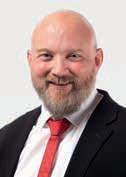
Environmental protection also plays an essential role at KAESER KOMPRESSOREN. We strictly limit noise, exhaust, and drainage emissions to the maximum legal standards and are committed to reducing them further.
Resource conservation is integrated into every aspect of our operations, from recyclable packaging materials and production inputs to the design of new products.
Social responsibility and fair working conditions for all employees are also central to our sustainability efforts. We support ongoing training, professional development, and career advancement to help our employees thrive and to take them through to retirement with the necessary skills.
Our commitment to a respectful and trusting relationship with all employees, regardless of age, gender, or background is also paramount. We consistently communicate and foster our company values, including a respect for tradition, customer focus, honesty, trust, respectfulness, discipline, reliability, curiosity, and an eagerness for innovation.
Sustainability not only protects our environment but also enhances working conditions, gives our work greater purpose, and ultimately strengthens our company’s resilience and competitiveness.

BrauBeviale is the barometer of the beverage industry – an essential fixture in the annual calendar. It is where mid-sized companies meet global players, traditional businesses mix with start-ups, and young talents connect with seasoned experts, all with the common goal of advancing the beverage industry with sustainable solutions.
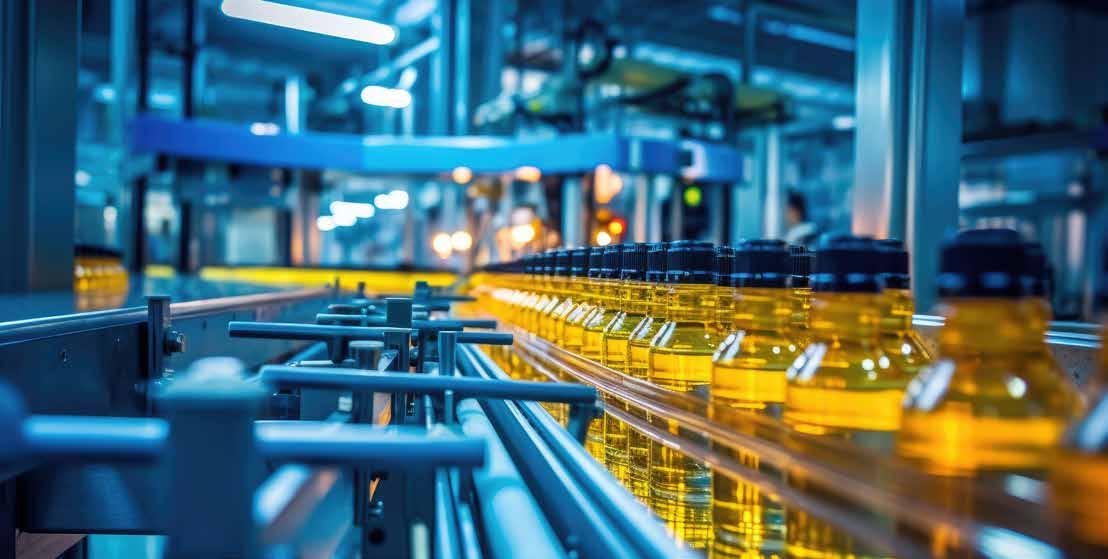
BrauBeviale is one of Europe’s leading trade fairs for the beverage industry. Since 1979, it has been held annually at the Nuremberg Exhibition Centre, taking a break every fourth year when the “drinktec” event takes place in Munich.
As diverse as the beverage industry itself, BrauBeviale’s offerings cover the entire process chain of beverage production, from raw materials, technologies and components to packaging, accessories and marketing ideas. As is well known, nothing in the brewing and beverage industry functions without compressed air. This alone is sufficient reason to explore how it can be provided as economically and sustainably as possible. At this year’s BRAU, KAESER KOMPRESSOREN will be showcasing the future technologies that the Coburg-based compressed air systems provider is using to ensure companies in the beverage industry are fit for tomorrow.
With the new FBS 720 rotary screw blower series, KAESER sets a new benchmark when it comes to efficiency and space-
saving design. The SFC version is equipped with an integrated frequency converter and a synchronous reluctance motor that meets the highest efficiency class of IE5.
As a slip-free motor, this design combines the advantages of highly efficient permanent magnet motors with the durability of asynchronous motors. Moreover, the convenient design of these new rotary screw blowers also makes side-by-side installation possible.
Impressively effective sound and pulsation damping ensure quiet operation, whilst variable speed control enables the flow rate to be adjusted according to demand. The internal SIGMA CONTROL 2 blower controller and the SIGMA AIR MANAGER 4.0 master controller provide more than just optimised blower air system efficiency –thanks to their numerous interface options, they can easily be integrated into advanced production, building management and energy management systems, as well as Industrie 4.0 application environments.
The new oil-free CSG rotary screw compressor series sets new standards in terms of purity and efficiency. The heart of the system, the rotary screw airend, is equipped with an innovative PEEK coating, making the CSG ideal for all applications in the food and pharmaceutical industries. The key properties of this water-based, bio-
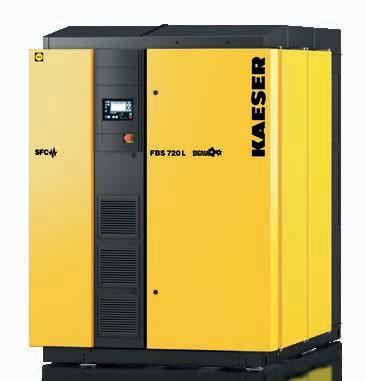

compatible coating are its high abrasion resistance and excellent food safety (certified in accordance with both European Regulation EC 1935/2004 and the American FDA food guidelines).

The new CSG series features effective water jacket cooling, which is more efficient than conventional oil jacket cooling and provides optimal operation even at higher ambient temperatures. By taking advantage of heat recovery, you can further reduce your energy consumption and improve your company’s CO2 footprint! With the optionally selectable heat recovery module in our water-cooled systems, water can be heated up to 90 °C and used for production or heating purposes.
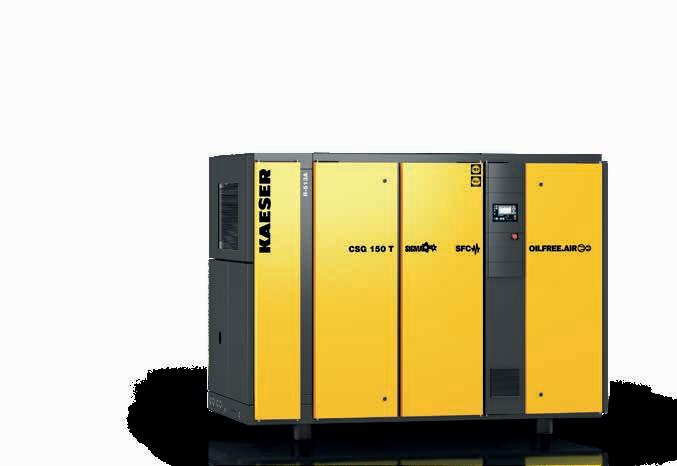

The new compressed air station makes a huge contribution to supporting our sustainability philosophy.
Andreas Nittke – Head of Energy, Plant and Operations Technology
Over 100 years of success
For over 100 years, global tool manufacturer Marbach has been supplying its customers in the cardboard, corrugated board and plastics industries with innovative cutting tools, thermoforming tools, technologies and services. Marbach solutions are synonymous with minimal setup time, high packaging quality, as well as safe and efficient processes.
Marbach’s extensive portfolio is divided into two areas: Marbach Die-Cutting Technology supplies the global packaging industry with tools for producing packaging from cardboard and corrugated board for the pharmaceutical, cosmetics, food and technical product sectors. In addition, Marbach offers machines, materials and other services related to die cutting. Marbach Tool Manufacturing provides the global packaging industry with thermoforming tools for producing cups, lids and meal trays from plastic for the food sector. The portfolio also includes various services related to thermoforming, as well as form, fill & seal (FFS) solutions and high-precision special applications.
The mechanical workshop founded by Karl Marbach Sr and two partners in Heilbronn in 1923 marked the beginning of a company history that reads like the narrative from a thriller novel. Over its more than 100 years of existence, Marbach has overcome numerous challenges: inflation, war, recession, pandemic and supply crises. Yet nothing could halt the company’s success. This was due in no small part to a bold decision made by Karl Marbach Jr, the founder’s son: despite the enormous inherent risk, in 1972 he invested in a technology that was unique in European die-cutting technology at the time – the first CNC-controlled CO2 laser-cutting system for die making. The introduction of this technology represented a quantum leap in die making and
established Marbach as a pioneer and market leader in Europe. The company continued to cement its position as an innovation leader in the years that followed. The use of laser technology for the manufacture of cutting tools was therefore not only a major milestone for the Marbach Group and the European die-cutting industry as a whole, but is the foundation of the company’s success.
Today, the production halls at the Heilbronn site house 7 of the 78 laser-cutting systems installed worldwide, which together account for approximately 40 percent of the compressed air consumption for Marbach’s die-cutting technology division. Compressed air is also used as control
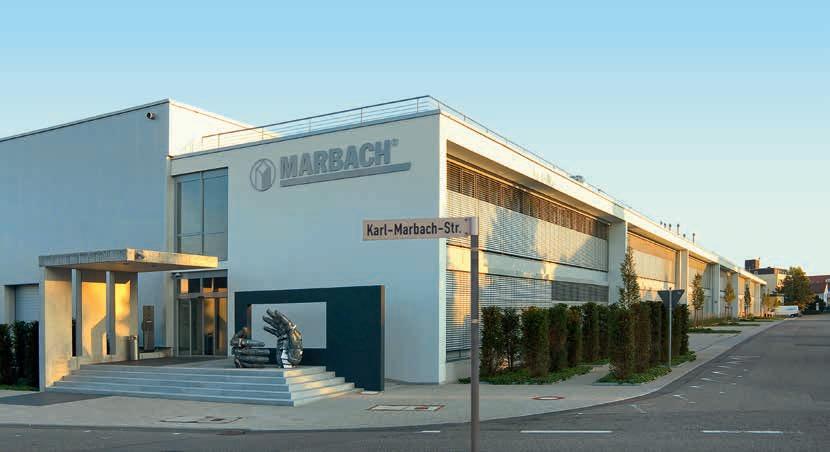
air and for test runs on the thermoforming machines.
In this process, the heated film is pre-stretched with a stamp and then fully shaped with compressed air. The compressed air remains in the mould during the cooling period, pressing the item against the mould so as to ensure cooling. Marbach’s overall annual compressed air demand is approximately 4.5 million cubic metres, and the company had been considering improvements to its compressed air supply since 2015. Andreas Nittke (Head of Energy, Plant and Operations Technology), summarises the initial situation: “Continuous production expansion has repeatedly led to increased demand for compressed air, causing the old compressed air station to slowly reach its limits. There was a lack of redundancy, and we wanted to find a new, self-contained and centrally located site in the compressed air network for the new station in order to address existing problems with pressure losses, high ambient temperatures in summer, and emissions.” Sustainability is a key priority at Marbach, so another important goal was to ensure that the new systems would operate with considerably greater resource and energy efficiency. As part of the process to assure opti-
mal design of the station as a whole, apprentices trained as Eco-Scouts were sent out in advance to identify unnecessary compressed air consumers as part of the needs assessment. Marbach has been supported for many years by a specialised dealer based in the Heilbronn area, so Andreas Nittke reached out to his longtime contact.
Today, the new compressor room houses a number of KAESER rotary screw compressors: one BSD 75 (delivery volume 4.43 to 7 m³/min, pressure 8.5 to 15 bar), two CSD 125 (delivery volume 8.6 to 12.02 m³/min, pressure 8.5 to 15 bar), and a frequency-controlled CSDX 140 (delivery volume 9.86 to 13.74 m³/min, pressure 7.5 to 13 bar) to cover peak demand.
Two energy-saving SECOTEC TF 340 refrigeration dryers (flow rate 34 m³/min) are used to provide reliable compressed air treatment. The SIGMA CONTROL 2 internal controller and the SIGMA AIR MANAGER 4.0 master controller work together to ensure efficient coordination of all components within the compressed air system, thereby enabling
maximum energy savings. According to current calculations, the new compressed air station saves approximately €20,000 per year in energy costs.
To improve the inlet and exhaust air situation, which previously led to high ambient temperatures during the summer months, it was decided that a new room would be created in the basement level of the building, which, due to its exterior wall, provides optimal conditions for the inlet and exhaust air ducts. Moreover, since the room is located near the heating system, it is the ideal site to facilitate heat recovery from the waste heat generated by compression, thanks to the use of plate-type heat exchangers. This allows the company to save approximately €30,000 in heating costs.
Andreas Nittke is more than satisfied: “Annual energy consumption is now approximately 100,000 kWh lower than in the comparison period with the previous system. With heat recovery, this corresponds to a CO2 saving of 104 tonnes. That’s a huge success in terms of sustainability.”

Founding a company out of passion – this was a matter very close to the heart for the two managing directors Yohannes Woldegergis and Stefanos Hormann. Their company, i-ProDens, manufactures custom frameworks for highly aesthetic and compatible dental prosthetics, and supplies perfectly matched accessories. With their ideas and technical expertise, they have actively supported digitalisation in the dental laboratory sector.
As long-time employees of Kulzer, Yohannes Woldegergis and Stefanos Hormann were given the opportunity to take over Kulzer’s ‘cara’ production centre in the summer of 2019, and they didn’t hesitate for a moment. Yohannes Woldegergis recalls, “We had just flown back from our summer holiday and went straight to the notary to sign the purchase agreement. Everything happened very quickly after that, and we had to set up all of the business processes for i-ProDens within three months. We didn’t have much time, but despite everything, we were able to launch the new company on schedule in January 2020.”
i-ProDens GmbH develops digital processes for dental technology and manufactures custom frameworks for both fixed and removable dental prosthetics from a variety of materials on behalf of dental technology and practice laboratories. As pioneers in the industrialised production of custom dental prosthetics using CAD/CAM processes, the two managing directors are keenly passionate about new ideas. Their goal of making work easier for dental technicians and dentists in both practice and laboratory settings is achieved through highly streamlined processes. For over 15 years, they have been developing their own software solutions for in-house implant structures such as i-Bridge®X and i-Butment®. The use of high-quality materials in both additive and subtractive processes guarantees precise frameworks.
The excitement of the launch phase continued for i-ProDens over the next three years: in 2023, they relocated to their new site in the Wolfgang Industrial Park in Hanau so as to have sufficient space for their work and accommodate future expansions. This came with its challenges however: very little time was available for renovation and relocation. As Yohannes Woldegergis explains, “There was no Plan B. The only option was for everything to go ahead as planned. Thanks to the tireless efforts of everyone involved, everything did indeed work out on time.”
Bright, light-filled rooms provide ample space for technical equipment, which is available to all 27 employees at their workstations. The entire building is constructed according to the latest energy science criteria to keep energy use and costs as low as possible. Naturally, this principle also applied to the planning of the compressed air supply. Compressed air plays a significant role at every workstation. All machines require compressed air as process and control air, as well as for cleaning and blowing off workpieces. Compressed air is used in a particularly interesting process within the context of 3D metal print-
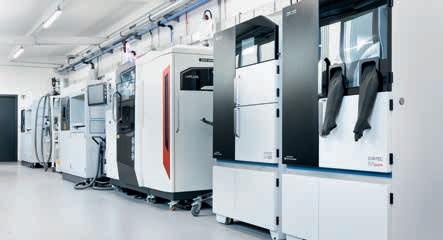
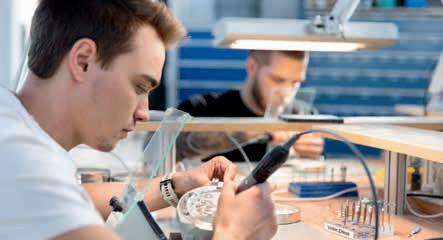

ing, whereby highly complex frameworks such as superstructures, cast models, primary and secondary parts, as well as crowns and bridges, are manufactured efficiently and consistently at the highest quality using laser melting. However, the prerequisite for this application is that the environment in the processing area where the compressed air is needed must be as free from oxygen as possible. Due to the sensitive materials involved, a compressed air purity class of 1-4-1 as per ISO 8573-1:2010 is required.
Heating with compressors?
At the previous site in Hanau, compressed air was a purchased product. Unsurprisingly, this supply method was very expensive. It was clear that investment in a modern, highly efficient compressed air station would significantly reduce energy consumption and, consequently, compressed air costs. As a result, focus was placed on sustainability, energy efficiency, and the possibility for comprehensive monitoring when planning the new station. Moreover, the operators wanted to cover the company’s entire heating demand through heat recovery, made possible by internal platetype heat exchangers in the compressors.
The resulting highly efficient compressed air station comprises two
Without compressed air, not a single tooth can be made here.



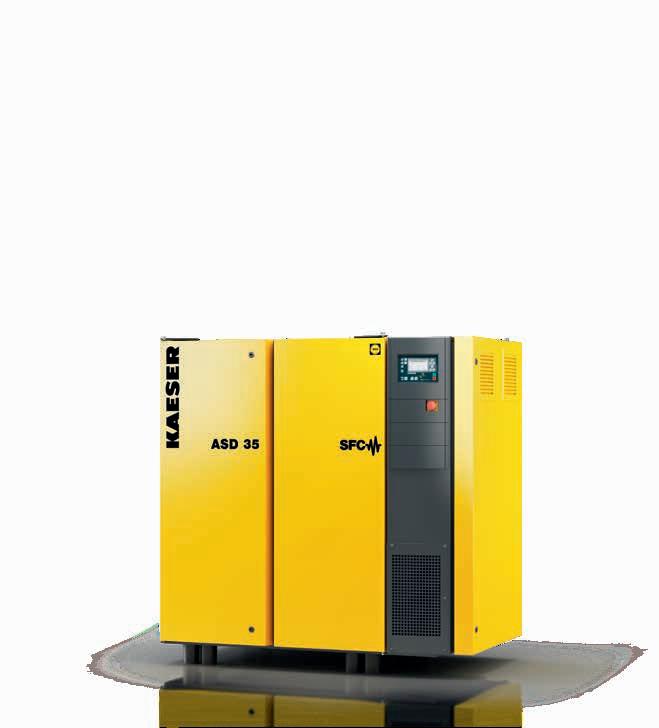
Yohannes Woldegergis, Managing Director
ASD 35 rotary screw compressors (7.5 to 10 bar, flow rate 2.63 to 3.15 m³/min) and a frequency-controlled ASD 35 (7.5 bar, flow rate 0.88 to 4.00 m³/min) with a synchronous reluctance motor that covers peak demand. These new-generation ASD rotary screw compressors not only produce more compressed air for less energy, but also combine exceptional versatility, ease of use and straightforward maintenance with environmental friendliness. The two SECOTEC TD 94 energy-saving refrigeration dryers ensure consistently dry air with maximum reliability.
Has the goal of meeting the company’s heating requirements using the exhaust heat from the compressors been achieved? As Yohannes Woldegergis happily confirms, “Thanks to heat recovery, we are able to completely eliminate the use of fossil fuels and cover the heat demand of the entire company building in a CO2-neutral way, solely by reusing the heat from the compressors. This measure alone saves us €20,000 annually in heating costs. We are very satisfied with the new compressed air station.”
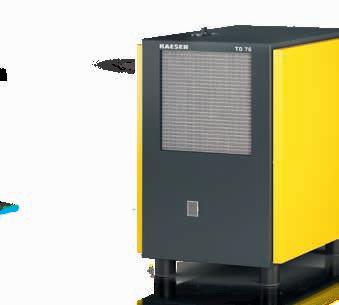


In a challenging alpine environment at an altitude of 4,554 metres, the “Capanna Regina Margherita” mountain hut is the site of a collaboration between scientists from the Polytechnic University of Milan and the Italian Alpine Club. Here, using portable compressors from KAESER, a research team is installing sensors for the purposes of monitoring permafrost conditions and rock stability.
Named after Queen Margherita of Savoy, the “Margherita Hut” is the highest alpine hut in Europe, situated at an elevation of 4,554 metres above sea level. The hut is located in the Monte Rosa group (Valais Alps), on the Swiss-Italian border between the towns of Alagna and Zermatt. Its establishment dates back to a resolution by the delegate assembly of the Italian Alpine Club in 1889 to build a mountaineer accommodation and research station on the summit.
To this day, the mountain hut houses scientific facilities for highaltitude medical experiments, in addition to an observatory.
In September 2023, work began in the immediate vicinity of the Margherita Hut as part of a project led by Francesco Calvetti, Professor of Geotechnics at the Polytechnic University of Milan, in collaboration with the Italian Alpine Club (CAI). The research project’s goal was to assess the condition and stability of the surrounding permafrost and the safety of the overlying structures by measuring various data. Soon, geologists Andrea Tamburini, responsible for data processing and analysis, and Fabio Baio – a seasoned expert in glaciology and permafrost drilling thanks to his numerous assignments in Antarctica and the Alps – joined the project. We had the opportunity to talk with Fabio Baio about the details and background of the research project.
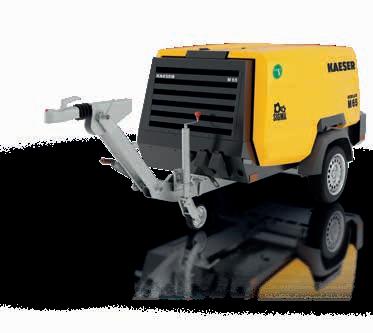
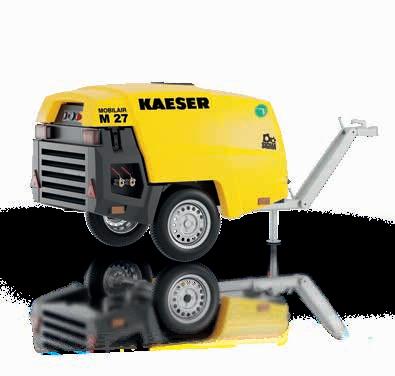
The reliability and performance of the compressors are decisive factors for the success of the project.
Dott. Fabio Baio
Image left: The payload capacity of the transport helicopter had to be taken into account when selecting the compressors.
Image right: MOBILAIR portable compressors are well equipped for demanding, continuous use on construction sites, even under harsh climatic conditions.
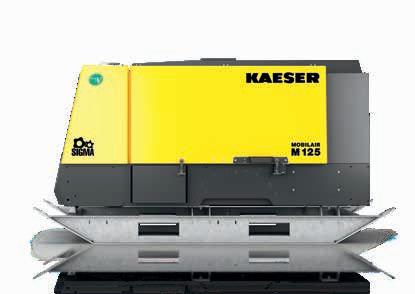
Dott. Baio, what is the purpose of the project?
This project aims to measure and evaluate the quality and stability of the rock using suitable measuring instruments, as well as to record temperature and vibration values that may indicate events such as earthquakes or collapses. For installation of the sensors that collect the measurements, two boreholes were drilled near the hut, one horizontally and one vertically. This allows the sensor chain, connected to a strain gauge, to monitor the condition of the permafrost and the stability of the rock.
What role does compressed air play in this project?
Compressed air played a crucial role as an energy source for the drilling operations required to install the measuring and testing instruments. For our application, two
diesel-powered portable compressors from KAESER’s MOBILAIR range provided the perfect solution.
What were the selection criteria for the compressors?
We selected the compressors based on several factors: first, we needed to meet the delivery volume requirements for the drill, which were 6 to 7 m³/min (at 5 to 7 bar pressure). We also considered the unavoidable performance losses due to the lower oxygen content in the high-elevation atmosphere compared to standard conditions. Lastly, we took into account the payload capacity of the helicopter used to transport the equipment to the site. We chose two portable compressors from KAESER’s MOBILAIR range, which, with their weight of less than 750 kg, could easily be transported by helicopter.

KAESER MOBILAIR units are well equipped for demanding, continuous use on construction sites, even under harsh climatic conditions. They reliably deliver the required compressed air quality thanks to numerous optional treatment components. The Anti-Frost Control automatically adjusts operating temperature to the outside temperature.
Dott. Baio, what did you think of the performance of the MOBILAIR units overall?
The KAESER units performed flawlessly and more than met our expectations. In this extreme and unpredictable alpine environment, the reliability and performance of the machines are essential to ensure smooth operation of all tools and equipment. Their exceptional reliability, even under such extreme climatic conditions, provided us with

the necessary compressed air to operate the instruments and monitor the various environmental parameters, enabling us to properly conduct all activities related to the project’s measurement objectives.


Sustainability is the topic of the future, and TUBEX has been delivering sustainability for years. Reusing aluminium for the production of aerosol cans not only saves 95% of energy costs, but also conserves resources, time and transportation. For this reason, TUBEX, together with highly specialised partners, has developed a patented aluminium alloy containing up to 60% real PCR® (Post-Consumer Recycled aluminium from the recycling bin). This contribution to sustainability benefits both customers and the environment.
The foundations for TUBEX were laid in 1947 by Consul Dr Alexander Grupp in Rangendingen, Baden-Württemberg, with the production of aluminium tubes. There are 1700 employees in the TUBEX Group as a whole, of which 300 are currently employed at the Rangendingen site. TUBEX’s eight locations are spread across Germany, Slovakia, Hungary, Russia and Austria, and the company forms part of a globally operating corporate group headed by CEO Dr Cornelius Grupp. With over 75 years of experience, the company supplies customers in the cosmetics,
food, pharmaceutical and technical industries with award-winning aerosol cans, tubes and bottles made from aluminium. A strong commitment to innovation in harmony with the environment forms the foundation for the continuous development of new, ground-breaking packaging solutions that protect both the packaged products themselves and our environment.
In Rangendingen, aluminium aerosol cans are manufactured for international companies in the cosmetics, technical and food industries. Renowned customers, including Beiersdorf, L’ORÉAL and Unilever, have trusted TUBEX products for years. The company is renowned for its excellent decoration and extreme shaping of aerosol cans, which have repeatedly won awards in the past, including the German Packaging Award, WorldStar Award and Can of the Year.
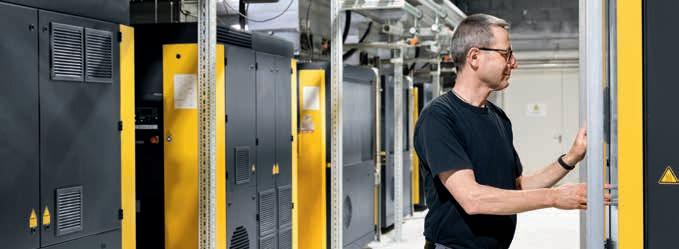
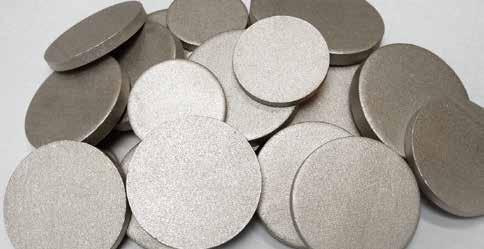
The subject of sustainability is very important at TUBEX. In 2021, an extensive project was launched in Rangendingen with the aim of increasing company energy efficiency and sustainability, and of reducing its carbon footprint. One key area of the project focused on the energy efficiency of the compressed air station and intelligent use of the energy generated during compression (heat recovery).
The operator was completely won over by KAESER’s perfectly coordinated, holistic concept. The existing KAESER compressors were relocated to a new, central compressor room in order to make the energy from heat recovery available where it was needed, whilst some new systems were also added to amply cover the company’s increasing compressed air demand. Today, the compressed air station comprises a total of seven KAESER rotary screw compressors from the DSD series (one DSD 172, three DSD 202s, one of which is equipped with SFC, one DSD 145 and two DSD 205s). Various compressed air treatment components (three TG 520 energy-saving refrigeration dryers, three AQUAMAT CF 75 oil-water separators and various filters) ensure the necessary compressed air quality.
The centrepiece of the compressed air station, however, is the new master control system. “The SIGMA AIR MANAGER 4.0 brought the entire concept together as a whole, and it was this aspect that completely convinced us,” explains Wolfgang
With KAESER’s service package, we don’t really need to handle anything ourselves in that regard any more.
Wolfgang Higi, Head of Toolmaking and Technical Training
Higi, Head of Toolmaking and Technical Training. “With this master control system, all relevant data are accessible at any time, and in the event of a fault, I receive a notification on my phone. With the previous system, we had a demand pressure of up to 6.9 bar, whereas with the new one it is possible to specify a minimum pressure. This allows us to reduce the demand pressure to 6.2 bar, which results in an energy saving of 7-8 percent. Last but not least, the easy availability of data is important for our energy management system.”
The smart all-inclusive package
Moreover, the SIGMA AIR MANAGER lies at the heart of the new service concept, SIGMA SMART AIR: the combination of remote diagnostics and demand-based, predictive maintenance provides maximum supply security while minimising life-cycle costs. There are no additional costs for the necessary connection technology or the sensors, as KAESER provides this technology for the entire term of the contract. The SIGMA AIR MANAGER 4.0 is not only

responsible for optimised, energy-efficient control of the systems within the station, but – when connected to the Sigma Network – also provides operational, service and energy data from the compressed air systems in real time. The process data are transmitted encrypted and in real time via a wireless modem; this has the advantage of keeping the customer’s network untouched and all data protected. The transmitted compressed air data are continuously monitored and analysed in the KAESER Plant Control Center. Therefore, compressed air system downtime – and consequently, production downtime – is avoided, ensuring the effectiveness and efficiency of the systems throughout their entire life cycle.
Wolfgang Higi is very satisfied with the compressed air station and the service package from KAESER. “Notifications from the compressed air station come directly to my phone, allowing an immediate response, and maintenance is scheduled in advance. I don’t really need to handle anything in that regard any more. This service is positive for both sides.”
In Rangendingen, aluminium aerosol cans are manufactured for international companies in the cosmetics, technical and food industries.


On the road to success with heat recovery
Müller + Müller is a company with a rich tradition. Founded 100 years ago in the Thuringian Forest and rebuilt in Holzminden at the end of the 1940s, it has grown to become part of the international DWK Life Sciences Group. The company is a leading manufacturer of primary packaging made from tubular glass, particularly vials, for the global pharmaceutical industry. These high-quality vials are crucial for various applications, including COVID-19 vaccines.
As the headquarters for the Pharma Packaging division within the DWK Life Sciences group, Müller + Müller is poised for significant expansion both in Holzminden and internationally in the coming years. A major step in this direction was taken with the construction of Hall 4, completed in 2023. Florian Müller-Stauch, Managing Director at Müller + Müller since 2015, explains: “Currently, around 300 million vials are produced annually at the Holzminden production site on state-of-the-art production lines.”
Müller + Müller offers a wide range of glass vials from 2 ml to 40 ml, with various neck finishes (injection vials or screw cap vials). The raw material for the vials consists of 1.5-metre-long glass tubes, which are processed vertically on stateof-the-art production lines according to customer specification. For special pharmaceutical products, Müller + Müller has been offering a unique silicone coating process for glass vials for several years: this invisible coating prevents the product from adhering to the inside of the glass vials, thereby ensuring optimal emptying. Dirk Brinkmann, Head of Plant Engineering, explains: “The entire process is continuously monitored by specialised personnel in a Class 8 cleanroom as per ISO 14644-1. The use of high-tech measuring systems guarantees consistently high quality.” Compressed air plays an important role in the siliconisation process (blowing out of rinsing liquid), as well as throughout the current 50 production lines (process air, control air, pneumatic handling). “The processes require a compressed air pressure of approximately 6 bar and a flow rate of 75 to 80 m³/min. Without compressed
air, none of these processes can operate,” says Dirk Brinkmann. Therefore, the close working relationship with KAESER, which has connected the two companies over the last 40 years, is very important to him.
Throughout this time, the company has continuously grown and expanded, and the compressed air station has been extended and modernised accordingly more than once. When the sili-
Thanks to heat recovery compressors, we have to drastically reduce costs.
Dirk Brinkmann, Head of Plant Engineering
conisation department was added in 2015 and compressed air demand increased yet again, the previous station gradually reached its limits. The decision to renew the compressed air station was made in 2021 as part of the planning for construction of the new Hall 4, which was to house seven new production lines in the future. These new systems were put into operation at the end of 2023, and the new compressed air station from KAESER has been reliably performing its duties ever since.
Heat recovery
From the outset, maximising energy-saving potential was a priority. This made KAESER rotary
screw compressors an obvious choice, as their optimised SIGMA PROFILE screw rotors enhance performance when it comes to specific package input power. Highly efficient IE4 motors further reduce power consumption, complemented by the loss-free 1:1 direct transmission of motor power to the compressor airend. The SIGMA AIR MANAGER 4.0 master controller ensures that the four DSDX 305 rotary screw compressors, including one equipped with a frequency converter, operate together precisely, in balance, and with maximum energy efficiency.
The SECOTEC TG 780 refrigeration dryers also provide exceptionally efficient operation thanks to their energy-saving control: in partial load operation, excess cooling capacity is stored in the thermal mass and can be used later on for drying without the need for additional electricity consumption.
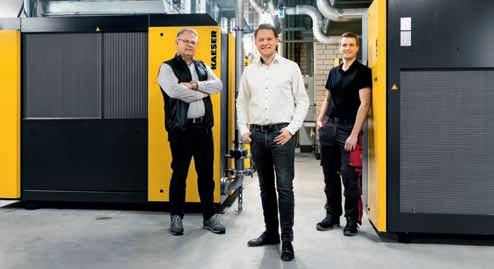
recovery from the have been able our heating
The highlight of this advanced compressed air station is its ingenious heat recovery system. Designed, planned and implemented with exceptional efficiency, it ensures that the company’s heating needs are fully met during production without the need for fossil energy sources. The 2000 m² warehouse is directly heated using exhaust air at 60 °C. Additionally, plate-type heat exchangers are used to relieve the heating system with the warm water that they generate. Therefore, the heating system only activates when no energy is available from production, such as on weekends. “By efficiently using both heat recovery systems (air and water) and reducing maintenance costs, we now benefit from an annual saving of approximately €40,000,” concludes Dirk Brinkmann with satisfaction.
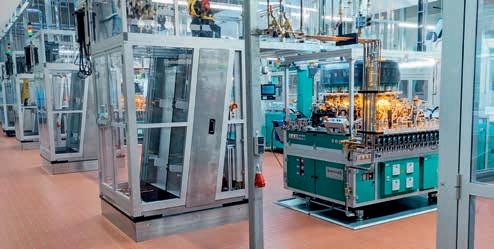
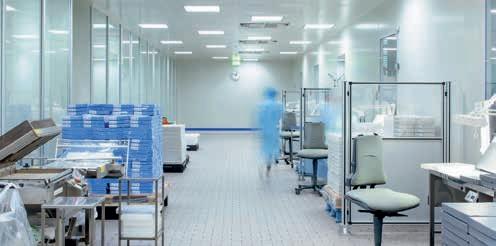

In Vienna, on the outskirts of the 17th district, a unique business operates out of an old coachman’s house. For four generations, this company has been producing Austrian snow globes and exporting them worldwide.
Vienna in 1900: The metropolis on the Danube was the capital of Austria and the seat of the Habsburg monarchy. During the reign of Emperor Franz Joseph I, Vienna flourished as a centre of fine arts and sciences. In this era of creativity and innovation lived Erwin Perzy, a skilled surgical instrument maker. With a passion for tinkering and inventing, he embodied the spirit of his time, conducting experiments and trials in his small workshop at his parents’ home. The invention of the snow globe was actually a happy accident. As chance would have it, Erwin Perzy was working on a project to improve the light output of the Edison light bulb. Doctors and hospital staff, with whom Perzy often collaborated, needed better lighting to perform surgery. In his search for a solution, Perzy experimented
with a water-filled glass globe placed in front of the Edison bulb. The globe acted like a magnifying glass, intensifying the light of the bulb in a small area in front of it. To enlarge the illuminated area, Perzy tried adding various substances to the water to scatter and amplify the light. One day, he decided to use semolina, which he noticed sank more slowly than other substances, creating a snowlike effect inside the globe. Since he was also working on creating miniatures of landmarks to be sold as souvenirs, he came up with the idea of combining a miniature church with the model of the globe. The first snow globe was born. He patented the idea and, in 1900, started a snow globe manufacturing business together with his brother. The business quickly became successful, and by the

1920s, Perzy’s snow globes were being exported overseas. Today, 300,000 snow globes are produced here annually, and the export business remains as successful as ever.
Sabine Perzy, Company Management
A charming greeting from Vienna
During a tour of the Snow Globe Museum, followed by a visit to the workshop, Sabine Perzy, great-granddaughter of the company founder, shared many fascinating details about the history and current operations of the snow globe manufacturing business. Except for the glass globes and packaging, everything is produced in-house. Today, the company utilises four injection moulding machines and nine 3D printers, capable of producing approximately 1,000 different designs, including custom orders for events such as weddings, births, baptisms, first days of school, and corporate events. The plastic figures are hand-painted with environmentally friendly, waterproof paints. The artificial snow inside the globes is no longer made from semolina; the exact composition remains a closely guarded company secret. However, it is known that the water inside the glass globes, which is crucial to the snow globe effect, is high-quality spring water from Vienna’s water supply.
Magic with compressed air
Compressed air has a surprisingly wide range of applications here. “That’s why it is
so essential for us,” reveals Sabine Perzy. “Without compressed air, even the skylights and display window wouldn’t open and close.” Compressed air is also used to eject figurines from the injection moulding machine and for pneumatic handling of the gripper robots. Moreover, all pneumatic cylinders and valves on the production machines are operated using compressed air. Compressed air is therefore crucial to every aspect of snow globe production. Over the years, the Perzy company has always sourced its compressors from KAESER and has maintained a very congenial partnership with the KAESER branch in Linz. Last year, when two new production machines were acquired, significantly increasing the demand for compressed air, the decision was made to replace the older KAESER compressor – which had always performed reliably – with a modern AIRCENTER SM 13. Quiet, powerful, durable and reliable, AIRCENTER compressed air stations from KAESER provide all-inone, premium-quality solutions for demanding customer requirements. This compact system houses the compressor, refrigeration dryer and air receiver all within a footprint of just one square metre, providing a convenient, space-saving and reliable compressed air supply for the business. Given their minimal space requirement, these premium compressed air stations are ideal for smaller industrial operations such as snow globe manufacturing. Sabine Perzy is very satisfied with the new AIRCENTER SM 13: “Due to our excellent experiences in the past, we chose a KAESER compressor again this time. We are now well-equipped for the years ahead.”
The snow globes enchant with over 1,000 different designs.
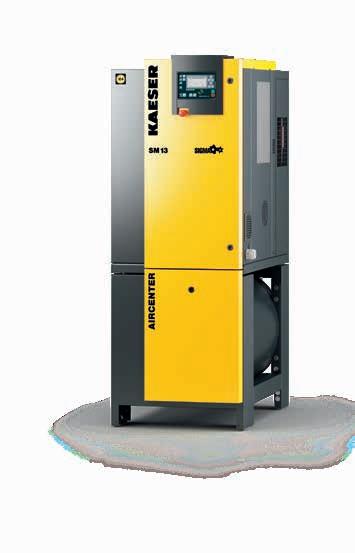
The plastic figures are hand-painted with environmentally friendly, waterproof paints.
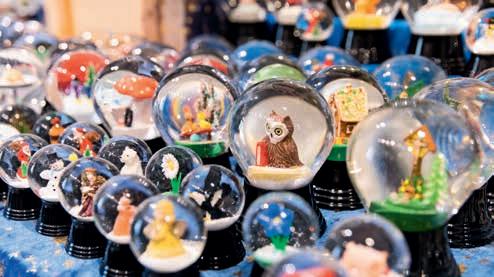
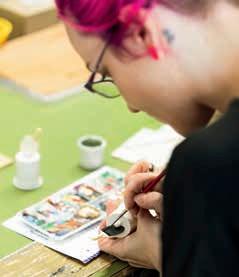


Waste and wastewater as sources of clean energy? This may sound utopian, but it is already a reality. These valuable resources can be converted into district heating, gas and electricity. Limeco in Dietikon is taking this a step further with its pioneering project: for the past two years, their power-to-gas technology has been producing CO2-neutral gas from wastewater and waste. This gas can subsequently be fed into the existing grid or stored for extended periods.
Purification of Limmattal’s wastewater is central to Limeco’s mission. The wastewater treatment plant mimics natural processes on a smaller scale: it screens, settles and filters out undissolved substances from the wastewater, while microorganisms remove dissolved organic compounds.
Waste and wastewater are resources that Limeco, a disposal company and energy provider in Switzerland, already converts into CO ₂-neutral energy in the form of heat, electricity and gas. In the spring of 2022, they achieved a significant milestone in the transition to renewable energy by establishing Switzerland’s first industrial power-to-gas plant.
Limeco’s waste recovery facility processes
95,000 tonnes of combustible waste annually from households, as well as construction and industrial sources. The heat generated during combustion is converted into environmentally friendly district heating for over 1,200 properties, including multi-family homes, large developments and commercial buildings.
Multi-energy hub in Limmattal
Furthermore, Limeco is now taking a highly innovative step towards a holistic approach in the form of a multi-energy hub. Instead of treating the energy sectors of electricity, heat and gas individually, these are integrated into a single system. Power-to-gas technology is crucial for this sector-coupling
strategy, which links electricity and gas in a sustainable energy system. Using excess renewable electricity, power-to-gas technology can produce methane that can be stored seasonally in order to address winter electricity shortages. In collaboration with eight partners, Limeco launched Switzerland’s first industrial power-to-gas plant at their Dietikon site (near Zürich) in the spring of 2022.
This project, initiated by Swisspower – an alliance of 21 municipal utilities – aims to advance the development and cost optimisation of power-to-gas technology within the Swiss energy system.
How does it work exactly? During the purification of Limmattal’s wastewater, sewage sludge is produced, which generates bio-

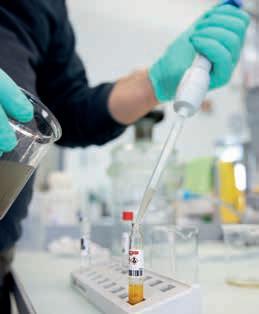
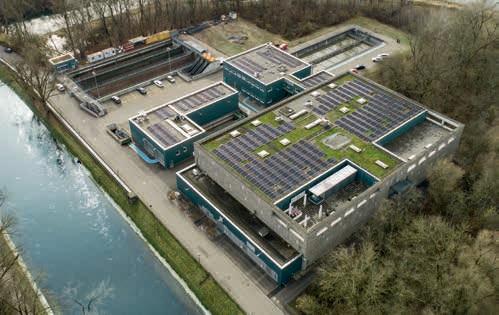
Purification of Limmattal’s wastewater is central to Limeco’s mission. The wastewater treatment plant (WWTP) mimics natural processes on a smaller scale. The water quality is continuously monitored using online measurement technology and in-house laboratory testing.
gas through a digestion process. This gas comprises two-thirds methane and onethird carbon dioxide. Concurrently, Limeco produces electricity from the combustion heat of the waste recovery facility. This electricity is used for electrolysis, which splits water molecules into hydrogen and oxygen. Some of the sewage sludge, along with its microorganisms, is pumped into a bioreactor, where the biogas and hydrogen are introduced. Here, microorganisms known as archaea come into play. They consume hydrogen and carbon dioxide and produce methane gas. This pure methane gas is then fed into the gas network. By burning green gas instead of fossil fuels, Limeco’s power-to-gas plant reduces annual CO2 emissions by approximately 5,000 tonnes.
As in any wastewater treatment plant, high-quality blower air is required for various steps in the wastewater purification process at Dietikon. Although energy is produced here, care is taken to ensure that the required blower air is supplied as energy-efficiently as possible. KAESER rotary screw blowers require significantly less energy compared to conventional rotary lobe blowers. KAESER rotary screw blowers are vital to four key processes when it comes to treatment of the wastewater: KAESER CBS 121 L rotary screw blowers are used for sand- and grease-trap aeration, while DBS 220 M rotary screw blowers ensure the oxygen supply for bacteria in the nitrification process (conversion of ammonium to nitrite and nitrate). Additional DBS 221 M rotary screw blowers produce air pulses to avoid dead zones in the anaerobic denitrification process. Last but not least, additional CBS 121 L blowers are used for the
pretreatment of the digested sludge water as part of the Anammox process. Beyond these wastewater treatment applications, KAESER rotary screw compressors are also employed at Limeco. SM 10 T units supply the compressed air needed to control all valves in the various wastewater treatment processes.
The pioneering power-to-gas project, which is the first of its kind in Switzerland, also uses compressed air from KAESER’s SM 10 T rotary screw compressors. These highly versatile compressors provide the control air for the valves in the powerto-gas plant. In January 2023, the Swiss Federal Office of Energy (SFOE) awarded the Watt d’Or for the 16th time. For establishing the first industrial power-to-gas plant, Limeco and its partners received the prestigious Swiss Energy Award in the “Energy Technologies” category.
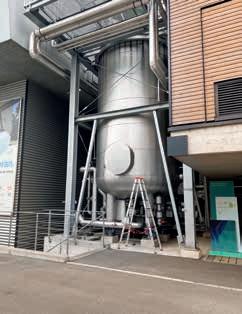
KAESER products impress with their exceptional efficiency and reliability, as well as their maintenance-friendly and well thought-out design.
Thomas Di Lorenzo, Head of Wastewater Management
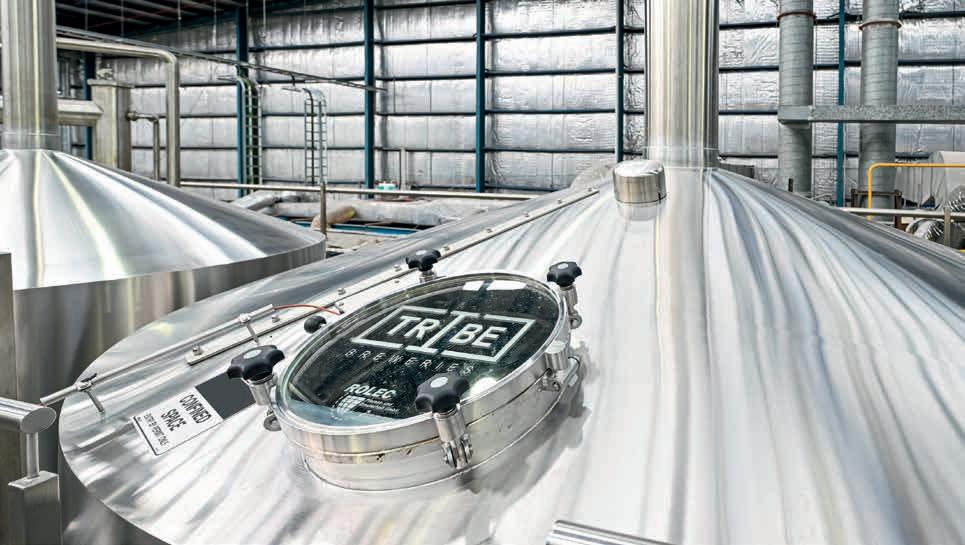
Nestled in the picturesque city of Goulburn in the Australian state of New South Wales, Tribe Breweries was formed from a collective of iconic craft beer brands. Today the company operates one of the largest breweries in the country.
Tribe Breweries boasts one of the most advanced beverage production systems in Australia; state-of-the-art technology is used in all areas of the business, including brewing, processing and packing. The facility in Goulburn has a capacity of some 30 million litres per year and, in addition to its own product portfolio, produces beverages for a multitude of brands that are subsequently distributed in an assortment of cans, bottles and barrels. With over 100 years of brewing experience, the company – which employs 100 staff from the city and its environs –has become a market leader in the manufacture of innovative, high-quality alcoholic beverages. Some of the most renowned, award-winning
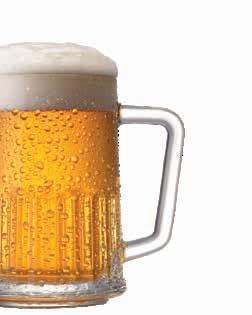
beverages in the country originate from this brewery.
Tribe Breweries takes environmental responsibility very seriously; in fact, its approach in this regard forms a central pillar of the company’s philosophy. This outlook shares much in common with that of KAESER KOMPRESSOREN, the Coburg-based compressed air systems provider – both companies are fully committed to reducing their ecological footprint and promoting sustainability in their business. Tribe Breweries incorporates its philosophy at many different levels, from containment strategies for environmentally harmful gas emissions to B Corp certification and the use of renewable energy sources (e.g. solar power). With the same objective in mind, KAESER KOMPRESSOREN’s innovative, energy-efficient products and services help customers to minimise the energy consumption of their compressed air systems and to operate sustainably.
Compressed air plays a crucial role at Tribe Breweries during all phases of the beer-brewing process. It not only ensures optimal conditions for yeast growth and fermentation, but is also indispensable for the filling and packaging of bottles, cans and kegs.
In 2018, KAESER COMPRESSORS Australia installed a cutting-edge, energy-saving compressed air station at the Goulburn plant, comprising a type CSG 55 oil-free compression rotary screw compressor, a SECOTEC TD 61 energy-saving refrigeration dryer, a 3,000-litre air receiver and various KAESER Filter products. Subsequently, the flourishing success of the brewery
Image left: Central compressed air station in the brewery.
Image right: Pneumatically controlled valves are an essential part of the operations at Tribe Breweries.
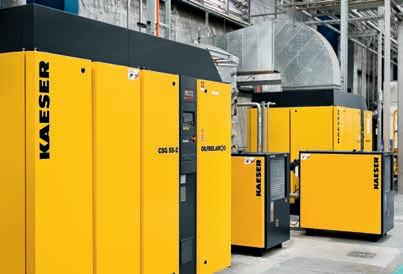

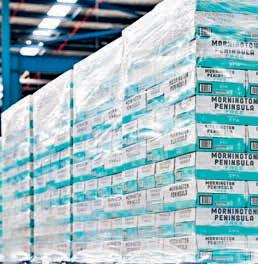
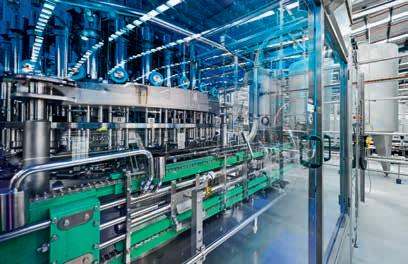
Image left: Tribe Breweries produces many different beer brands. Image right: Compressed air also plays an important role in the brewing process.
meant that production capacity needed to be expanded and with it the compressed air supply. Therefore, in recent years the compressed air station was expanded to the tune of an additional CSG 55 compressor and a second SECOTEC refrigeration dryer plus further KAESER Filter products; these were seamlessly integrated into the existing system, thereby enabling the growing demand of the brewery to be comfortably met.
Especially designed to ensure the compressed air remains free from impurities, state-of-the-art, oil-free CSG rotary screw compressors from KAESER provide a clean supply of food-grade compressed air in compliance with the strict demands of ISO 22000. This makes them ideal for applications in which compressed air quality is of the utmost importance, thereby enabling the integrity and purity of the
brewing process to be maintained in full. SECOTEC dryers feature highly energy-efficient refrigerant compressors that ensure low electrical power consumption. Their compact design and intelligent control system provide optimal performance with minimal energy use, making them a cost-effective solution for even the most demanding of air quality requirements.
KAESER Filter products are key components when it comes to meeting purity classes in accordance with ISO 8573-1. Not only do they benefit from exceptionally low differential pressure, but their service-friendly design facilitates simple, error-free opening
and closing of the filter housing and quick, clean element changes.
Piers Watson, Head of Assets at Tribe Breweries, is delighted with the decision to select KAESER technology. “We were already more than happy with the first KAESER system, so the decision regarding the second expansion stage was an easy one,” he explains. “The new system was easily integrated into the existing one and perfectly adapted our compressed air capacity to meet the growing demands of our operation. Once again, our highest expectations have been met”.
Sustainability is one of our most important company objectives.
Piers Watson, Head of Assets

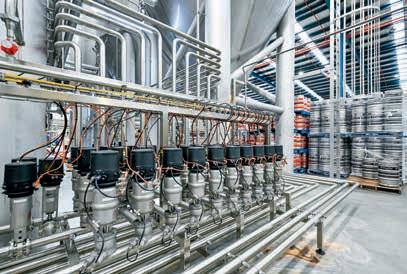
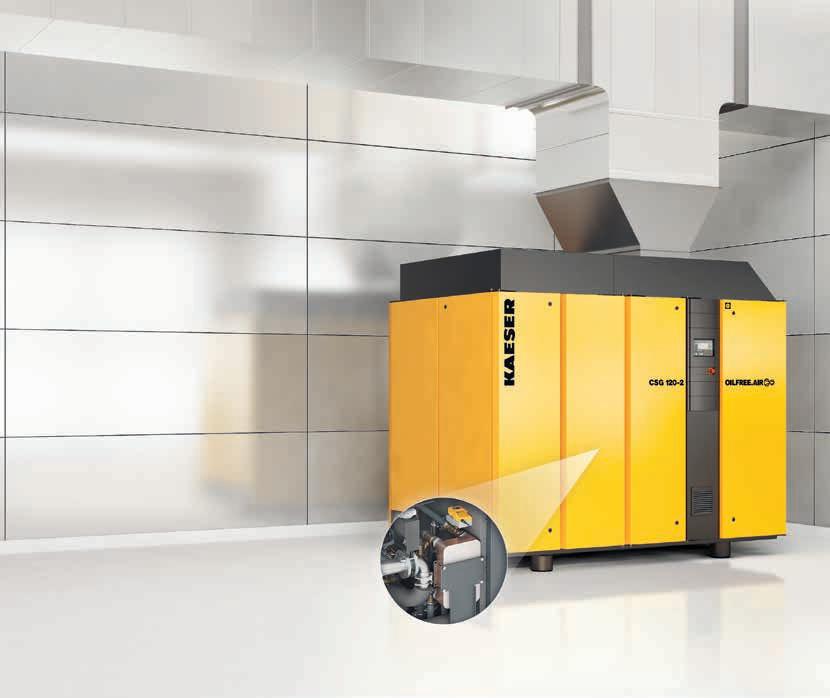
The right decision for sustainable energy savings
• Energy-efficient – Utilisation of compressor exhaust heat for room heating, heating support, or process water heating
• Sustainable – Significant CO2 savings potential
• Demand-based – Customisable water inlet and discharge temperatures to meet individual customer requirements
• Flexible – Available both as a factory option and as a retrofit for existing systems
• Funding opportunities – State funding programmes for energyefficiency measures
Up to 90% heat recovery potential